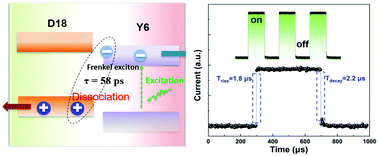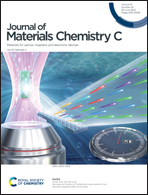A visible to near-infrared nanocrystalline organic photodetector with ultrafast photoresponse†
Abstract
Organic photoelectron conversion devices, due to their solution process and wide use in portable devices, have attracted intensive interest. Herein, a newly developed active layer of D18:Y6 is used to fabricate an organic photodetector and the device of ITO/PEDOT:PSS/D18:Y6/Phen-NaDPO/Ag shows a responsivity of 680 mA W−1 and a detectivity of 6.35 × 1013 Jones (1 Jones = 1 cm Hz1/2 W−1) at a wavelength of 850 nm. Additionally, this device shows a wide linear dynamic range of 120 dB, indicating a potential near-infrared region (NIR) detector system. Owing to the minimal exciton binding energy of 37.6 meV for Y6, a desirable energy offset for efficient electron–hole pair dissociation and an ultrafast charge transfer of ∼58 ps at the interface of D18:Y6, the obtained organic photodetector has demonstrated a photoresponse time as fast as 1.8 μs upon laser light excitation without an external driven voltage. More importantly, D18 shows a preferred out-of-plane orientation with strong intensities and Y6 exhibits a preferred orientation along the in-plane direction on lamellar stacking, which facilitates charge transport. This work has demonstrated significant progress in exploring D18:Y6 NIR organic devices with a wide photosensitivity linearity and ultrafast photoresponse.



 Please wait while we load your content...
Please wait while we load your content...